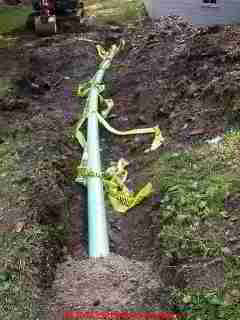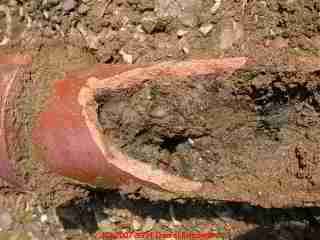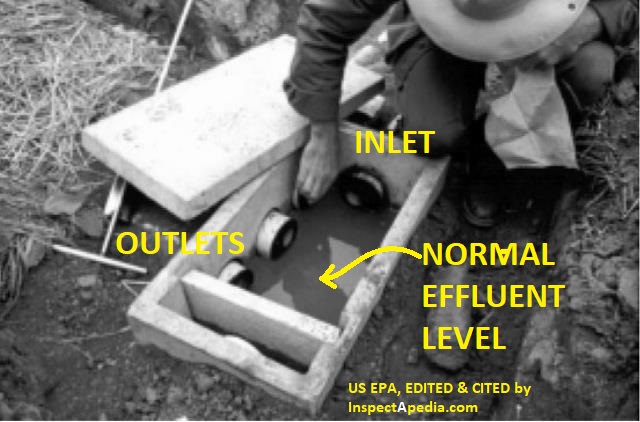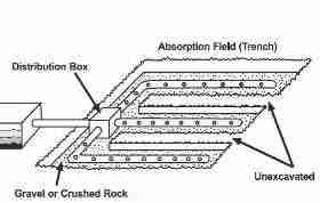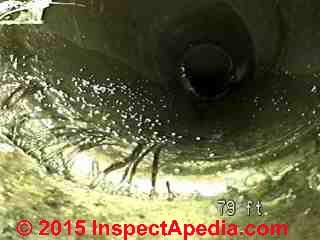 Sewer & Septic Pipe Clogs, Slow drains, Blockage
Sewer & Septic Pipe Clogs, Slow drains, Blockage
- POST a QUESTION or COMMENT about discovering clogged septic or sewer piping during the purchase of a home
Detect, diagnose & repair clogged sewer or septic piping:
Discovering clogged septic system piping during the process of buying a home or after you own means proper diagnosis is needed before a repair can begin:
This article discusses how to diagnose and repair clogged septic systems or piping. Septic backups, failures, breakouts, odors: This document provides advice for home buyers who are buying a home with a private septic system: homes using a septic tank and drainfield or similar soil absorption system.
This article series outlines what goes wrong with septic systems and their various components and describes septic inspection and test methods in detail, explains how to be sure your septic inspection and septic test are conducted properly, tells you where to get more septic system information about a given property, and warns of unsanitary or dangerous site conditions.
InspectAPedia tolerates no conflicts of interest. We have no relationship with advertisers, products, or services discussed at this website.
- Daniel Friedman, Publisher/Editor/Author - See WHO ARE WE?
Septic or Sewer Line Drain Pipe Clogs, Damage & Failures
Septic Main Drain or Municipal Sewer Piping Failures - Distribution Piping
[Click to enlarge any image]
Distribution piping connects the house drain to the septic tank, running between the building and the tank inlet.
More distribution piping connects the septic tank outlet to the distribution box and from there to the leach field.
Distribution pipes can settle (especially in new construction), break, become blocked or clogged, or become invaded and blocked by tree roots or soils as shown in the first photo above.
Clay pipes also break and have a tendency to become blocked by tree roots at their joints as happened here.
Older ORANGEBURG PIPE pipes which look like black asphalt-soaked cardboard (they are) crush and deteriorate with age.
You won't know what kind of piping
is installed until it is excavated, but the age of the property may be a clue.
Homes built from the 1970's on, certainly
from the 1980's on, use cast iron or more often plastic ABS or PVC piping for these connections, as shown in the
second photo above where we were replacing a root and mud-clogged clay sewer line with a new plastic line.
See DRAIN LINE REPLACEMENT diagnosing a clogged drain leads to drain line replacement"
for a step by step photo-illustrated guide to diagnosing failed septic piping (or sewer line) and the subsequent drain replacement procedure.
Septic Distribution Boxes
Distribution boxes serve as a connection point to distribute effluent which arrives from the
septic tank outlet and is to be sent into two or more individual leach field lines. Distribution boxes
("D-Boxes") can settle or tip.
A damaged or tipped D-box will fail to divert effluent uniformly among the
effluent receiving drainfield lines, causing flooding of one leach line.
If you see depressions suggesting that there are four leach lines at the property and the end of just one of them is producing wet soil or surface-breakout of effluent, we'd suspect a tipped D-box.
Photo courtesy U.S. EPA)
Details are at SEPTIC D-BOX INSTALL, LOCATE, REPAIR.
Septic Drainfield Piping Clogging
Drainfield piping is usually constructed of perforated pipe buried in gravel-filled trenches. It receives
effluent from the D-box and allows it to percolate or
seep into the soil around the trench where added filtering and
bacterial treatment occur. Like the distribution piping discussed above, individual drainfield pipes can become crushed,
shifted, or clogged by tree roots or other debris.
More general clogging and failure of the leach field is discussed below. A broken or clogged pipe, once it
has been located, may be
much less costly to repair than a complete leach field replacement, so this possibility needs to be
considered during diagnosis of a "failed" septic system.
We have more to say about septic distribution piping failures in the next section 4-3 where we
discuss Leach Field Failures.
Sewer or Septic Tank Drain Line Backups & Clogs Due to Bends, Roots, Slope Defects
Watch out: particularly at older properties the planting of trees and other shrubs, even some grasses risks root-clogging of older sewer or drain piping, particularly when the drain pipes are constructed of hub-joined terra cotta (photo above) or of orangeburg.
Roots find any leak or break in a sewer line. Using a rotary power snake can temporarily clear the clogged drain line if it is not severely broken or collapsed, but the roots will return unless the source-plant is removed or the cracked, leaky line replaced.
See PLANTS & TREES OVER SEPTIC SYSTEMS
A sewer line inspection camera can show the overall condition of a buried drain line including indicating defects in the sewer or septic piping.
Details are at SEWER / SEPTIC PIPE CAMERAS
Reader Question: is a 90 degree bend in the sewer line causing clogs & backups of our septic system?
Hi, I'm a veteran with a recurring problem with a septic system installed in 2006. The tank is located approximately 25 feet from the house. The pipe leaves the house - runs approximately 25 feet then makes a 90 degree turn and enters the inlet side of the tank approximately 1-2 feet from the 90 degree elbow. I was experiencing recurring back ups approximately 3 times per year-most embarrassingly during a family gathering. We had the tank pumped in Dec 2011.
There are only 2 residents in a 3-bedroom, 2 bath home so the tank should have sufficient size to handle this. Have not had any known issues since. However, just recently got a back up.
Each back up was successfully cleared by a roto rooter service - usually the clog seems to be right at the 90 degree elbow or at the inlet baffle area - can't really tell. I'm trying to understand the cause of these back ups. It's been suggested to re-pipe the inlet to create a long sweep turn versus the 90 degree elbow.
Not quite sure how this would eliminate the issue. If too much water is flowed into the tank - heavy wash day etc I can see how this might take a few minutes to flow through the filter and out to the leach field but why would a drain snake immediately fix the issue?
We use septic safe toilet paper, don't use the disposal, limit chlorine type cleaners, don't put grease or oil in the sink drains, regularly use yeast product to keep bacteria levels up. any advice or access to local expert in Metro Phoenix AZ would be helpful. thanks for any advice or things to check on. - J.C., Phoenix AZ 1/3/2014
Reply: quite possibly; notes on sewer line turns, bends, clogs & septic system / sewer line diagnosis & maintenance
A competent onsite inspection by an expert usually finds additional clues that would permit a more accurate, complete, and authoritative answer than we can give by email alone, and an experienced plumber might see some other problem such as a venting, pipe slope, tank baffle inlet or other problem, or even signs of a clogged, failing drainfield even though your immediate problem appears to be a drain issue.
See SEPTIC DRAINFIELD FAILURE DIAGNOSIS.
You will find additional depth and detail in articles at our website.
Because there is often confusion between a septic system failure and a drain problem, we've written CLOGGED DRAIN vs SEPTIC PROBLEM to help figure out where the problem lies.
But as you report that a drain cleaning snake ("roto rooter") has cleared the blockage and gotten the drainage system working more than once, I share your suspicion about the problem location - at that 90 degree turn of the waste line between the building and the septic tank.
That said I want to clarify the 90 degree turn problem. In good plumbing practice we would not ever install an actual 90 degree elbow in a sewer line. Such a sharp turn is indeed inviting clogs, even in steep slope or vertical drain sections. Rather the plumber will typically install two 45 degree bends to make a more gentle turn.
It makes sense to confirm that it's actually a 90 deg turn that was installed, and if so to replace it with two 45's. In the course of digging up that bend in the waste line, inspect the piping to identify the material and to confirm that there is no other damage. For example, in an older waste line that is cracked or broken open, soil spillage into the drain or root invasion into the drain can also lead to recurrent sewer line clogs and backups.
You can also take an initial step to confirm that there is or is not evidence of a problem in the septic tank and indirectly with the drainfield by opening and inspecting the septic tank at the inlet end of the tank.
Check that the SEPTIC TANK BAFFLES are in place, un-damaged, and that the wastewater level in the tank is at a normal level.
f you cannot find the septic tank see SEPTIC TANK, HOW TO FIND.
A few other comments on your note:
Without knowing the septic tank size I'm reluctant to assume anything about its adequacy, though I agree that a code-compliant septic tank installed in 2006 ought to have been matched to the anticipated number of occupants of the home. Similarly there can be hidden installation or other defects at any buried component such as sewer lines, cleanouts, a septic tank, distribution box or drainfield
. But before starting any costly digging project I'd want to have some reason to suspect that the trouble and expense were justified. Put another way, it makes sense to try the easy, lower cost exploration and repair steps first.
You comment that the septic tank was installed in 2006. It's now eight years later - you ought to take a look
at SEPTIC TANK PUMPING SCHEDULE .
Armed with an idea of the septic tank size and the number of occupants in the home you can guesstimate how often you should be pumping the tank - a step that extends drainfield life.
Watch out: You comment that you use a yeast product regularly "to keep bacteria levels up".
That is a bad idea, doesn't work, and can harm the septic tank and ruin the drainfield. Yeast levels have nothing to do with septic tank bacteria levels, and yeast can cause septic tank contents frothing and churning that forces solids into the drainfield, shortening its life.
You do not need to use septic tank additives in a conventional tank and drainfield, and some of those products are both harmful and in some jurisdictions, illegal as well.
Details are at SEPTIC TREATMENTS & CHEMICALS or select a topic from the closely-related articles below, or see the complete ARTICLE INDEX.
...
Continue reading at CLOGGED DRAIN DIAGNOSIS & REPAIR - topic home, or select a topic from the closely-related articles below, or see the complete ARTICLE INDEX.
Or see these
Septic or Sewer Line Articles
- SEPTIC SYSTEM TEST BASICS - quick guide for buying a home with a septic tank
- HOME BUYERS GUIDE to SEPTIC SYSTEMS - complete guide to buying a home with a septic tank
- HOME SELLERS GUIDE TO SEPTIC INSPECT
- ORANGEBURG PIPE
- PLANTS & TREES OVER SEPTIC SYSTEMS - cause of clogged or damaged sewer or septic piping failures
- SEWER BACKUP PREVENTION
- SEWER LINE CLOGS & DAMAGE
- SEWER LINE LEAKS & ODORS
- SEWER LINE REPLACEMENT
- SEWER / SEPTIC PIPE CAMERAS
- TRENCHLESS SEWER REPLACEMENT
- WAXY BIOFILM SLIME CLOGS in DRAINS & PUMPS
Suggested citation for this web page
SEWER LINE CLOGS & DAMAGE at InspectApedia.com - online encyclopedia of building & environmental inspection, testing, diagnosis, repair, & problem prevention advice.
Or see this
INDEX to RELATED ARTICLES: ARTICLE INDEX to SEPTIC SYSTEMS
Or use the SEARCH BOX found below to Ask a Question or Search InspectApedia
Ask a Question or Search InspectApedia
Questions & answers or comments about discovering clogged septic or sewer piping during the purchase of a home.
Try the search box just below, or if you prefer, post a question or comment in the Comments box below and we will respond promptly.
Search the InspectApedia website
Note: appearance of your Comment below may be delayed: if your comment contains an image, photograph, web link, or text that looks to the software as if it might be a web link, your posting will appear after it has been approved by a moderator. Apologies for the delay.
Only one image can be added per comment but you can post as many comments, and therefore images, as you like.
You will not receive a notification when a response to your question has been posted.
Please bookmark this page to make it easy for you to check back for our response.
IF above you see "Comment Form is loading comments..." then COMMENT BOX - countable.ca / bawkbox.com IS NOT WORKING.
In any case you are welcome to send an email directly to us at InspectApedia.com at editor@inspectApedia.com
We'll reply to you directly. Please help us help you by noting, in your email, the URL of the InspectApedia page where you wanted to comment.
Citations & References
In addition to any citations in the article above, a full list is available on request.
- New York State Department of Health, "Appendix 75-A Wastewater Treatment Standards - Individual Household Systems", [PDF] New York State Department of Health, 3 February 2010, retrieved 3/1/2010, original source: https://www.health.ny.gov/regulations/nycrr/title_10/part_75/appendix_75-a.htm
- Sketches of the Septic System Components Private Sewage Disposal Systems - Septic Drawing Library
Septic Systems - an Engineer's View
Septic System, Septic Tank, & Cesspool Safety Warnings for Septic Inspectors, Septic Pumpers, and Homeowners.
CESSPOOLS if you don't know what they are.
TOILETS, DON'T FLUSH LIST these things into a septic system
DRYWELL DESIGN & USES if you don't know what they are.
SEPTIC SYSTEMS ONLINE BOOK Online Book, Inspection, Test, Diagnosis, Repair, & Maintenance: Our Online Septic Book: Septic Testing, Loading & Dye Tests, Septic Tank Pumping, Clearances, details of onsite waste disposal system inspection, testing, repair procedures. - Inspecting Septic Systems: Online Book, Inspection, Test, Diagnosis, Repair, & Maintenance: our Online Septic Book: Septic Testing, Loading & Dye Tests, Septic Tank Pumping, Clearances, details of onsite waste disposal system inspection, testing, repair procedures.
- Country Plumbing: Living with a Septic System, Hartigan, Gerry: $ 9.95; ALAN C HOOD & TP; Quoting an Amazon reviewer's comment, with which we agree--DF
- "International Private Sewage Disposal Code," 1995, BOCA-708-799-2300, ICBO-310-699-0541, SBCCI 205-591-1853, available from those code associations.
- "Manual of Policy, Procedures, and Guidelines for Onsite Sewage Systems," Ontario Reg. 374/81, Part VII of the Environmental Protection Act (Canada), ISBN 0-7743-7303-2, Ministry of the Environment,135 St. Clair Ave. West, Toronto Ontario M4V 1P5 Canada $24. CDN.
- Manual of Septic Tank Practice, US Public Health Service's 1959.
- Water Wells and Septic Systems Handbook, R. Dodge Woodson. This book is in the upper price range, but is worth the cost for serious septic installers and designers.
Quoting Amazon: Each year, thousands upon thousands of Americans install water wells and septic systems on their properties. But with a maze of codes governing their use along with a host of design requirements that ensure their functionality where can someone turn for comprehensive, one-stop guidance? Enter the Water Wells and Septic Systems Handbook from McGraw-Hill.
Written in language any property owner can understand yet detailed enough for professionals and technical students this easy-to-use volume delivers the latest techniques and code requirements for designing, building, rehabilitating, and maintaining private water wells and septic systems. Bolstered by a wealth of informative charts, tables, and illustrations, this book delivers:
* Current construction, maintenance, and repair methods
* New International Private Sewage Disposal Code
* Up-to-date standards from the American Water Works Association
- Wells and Septic System, Alth, Max and Charlet, Rev. by S. Blackwell Duncan, $ 18.95; Tab Books 1992. We have found this text very useful for conventional well and septic systems design and maintenance --DF. Quoting an Amazon description:Here's all the information you need to build a well or septic system yourself - and save a lot of time, money, and frustration. S. Blackwell Duncan has thoroughly revised and updated this second edition of Wells and Septic Systems to conform to current codes and requirements. He also has expanded this national bestseller to include new material on well and septic installation, water storage and distribution, water treatment, ecological considerations, and septic systems for problem building sites.
- In addition to citations & references found in this article, see the research citations given at the end of the related articles found at our suggested
CONTINUE READING or RECOMMENDED ARTICLES.
- Carson, Dunlop & Associates Ltd., 120 Carlton Street Suite 407, Toronto ON M5A 4K2. Tel: (416) 964-9415 1-800-268-7070 Email: info@carsondunlop.com. Alan Carson is a past president of ASHI, the American Society of Home Inspectors.
Thanks to Alan Carson and Bob Dunlop, for permission for InspectAPedia to use text excerpts from The HOME REFERENCE BOOK - the Encyclopedia of Homes and to use illustrations from The ILLUSTRATED HOME .
Carson Dunlop Associates provides extensive home inspection education and report writing material. In gratitude we provide links to tsome Carson Dunlop Associates products and services.


